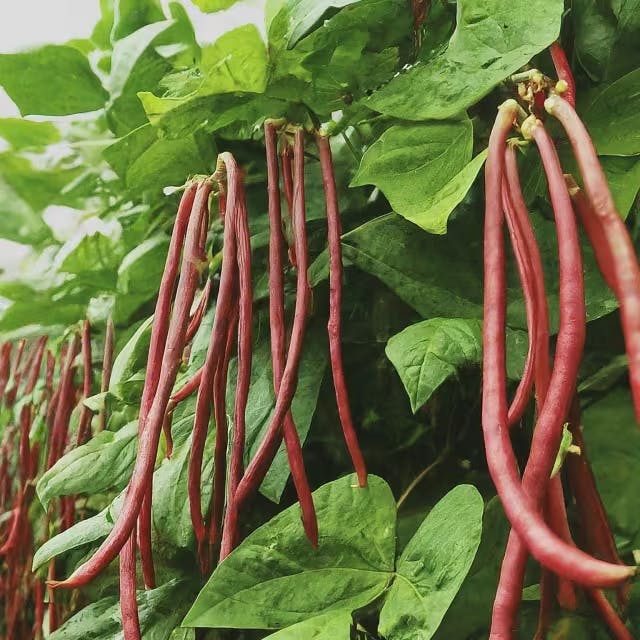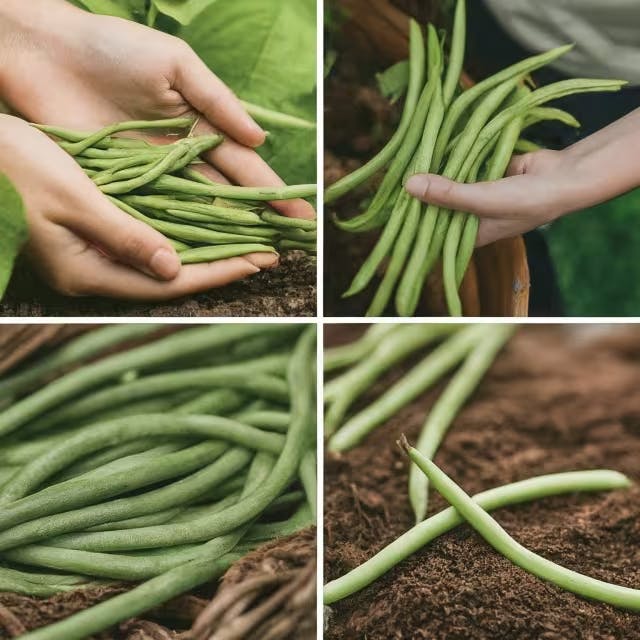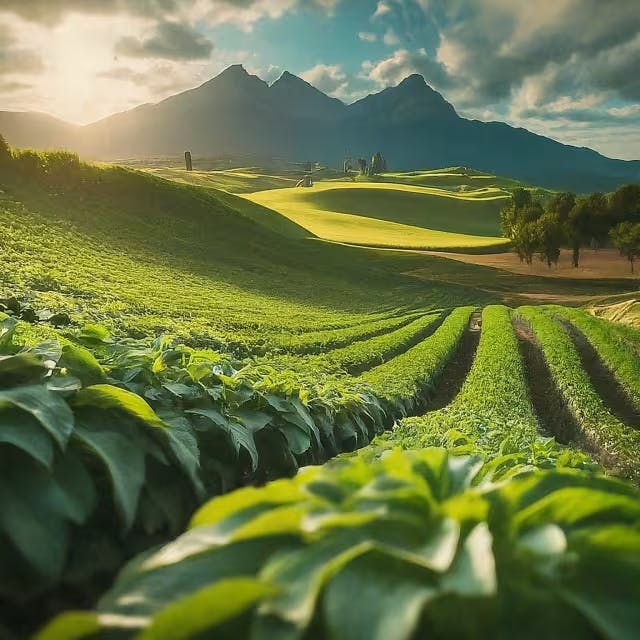Growing Chinese Red Noodle Yardlong Beans
Go4Turf
February 29, 2024

Exploring the world of home gardening can lead to some unique and intriguing discoveries, much like the adventure Pennsylvania-based garden blogger Nancy J. Ondra embarked upon with growing Chinese Red Noodle Yardlong Beans. Drawn to their ornamental beauty and potential for culinary use, Ondra's journey through planting 'Red Noodle' beans on her new orchard arch offers valuable insights for garden enthusiasts eager to add a touch of the exotic to their gardens. Despite facing challenges such as battling ants, wasps, and the beans' somewhat creepy resemblance to "lumpy little snakes," the allure of tasting these young, potentially delicious pods has piqued the interest in growing Chinese Red Noodle Yardlong Beans. This guide aims to provide you with everything you need to know, from understanding their unique features to optimizing their growth, and finally enjoying the fruits of your labor with delicious recipes.
Key Takeaways
Chinese Red Noodle Yardlong Beans offer both ornamental beauty and culinary value, making them an intriguing choice for home gardeners seeking to add exotic elements to their gardens.
Facing gardening challenges such as pests including ants and wasps, and the plants’ peculiar growth patterns, can be part of the adventure when growing these unique beans.
Understanding the specific needs of Chinese Red Noodle Yardlong Beans, from the optimal soil conditions to sunlight exposure, is crucial for successful growth.
Implementing proper watering, fertilizing, and pest control strategies is essential for optimizing the growth and yield of your Yardlong Beans.
Harvesting at the right time and storing the beans properly are key to enjoying the best flavor and extending the shelf-life of your produce.
Experimenting with different recipes can enhance the enjoyment of your homegrown Yardlong Beans, making the effort of growing them well worth it.
Understanding the Unique Features of Chinese Red Noodle Yardlong Beans
Gardening enthusiasts and culinary adventurers might find the Chinese Red Noodle Yardlong bean a fascinating addition to their green space. Distinct for its strikingly long, reddish-purple pods, which can grow up to 18 inches or more, these beans add a splash of color and an exotic flair to any garden. Beyond their visual appeal, these beans offer a crisp texture and a sweet, slightly grassy flavor, making them a versatile ingredient in a variety of dishes.
A key feature to note is their vigorous growth habit. Serving as both a functional crop and ornamental plant, these beans thrive when provided with a sturdy support. Trellises, arches, or any tall structure that facilitates vertical growth will not only maximize yield but also add an architectural element to your garden layout.
Harvesting at the right time is crucial for the best taste and texture. While they can grow considerably long, picking them when they are about 12-15 inches ensures they are still tender. Overly mature pods may develop a tougher texture and a more pronounced seed inside, which some might find less desirable for culinary use.
Given their Asian origin, Red Noodle Yardlong beans prefer warm temperatures and lots of sunlight. They tend to start off slow in cooler climates but pick up growth speed with the warmth of summer. For those in regions with short growing seasons, it might be beneficial to start seeds indoors to get a head start. For ideas on creating your seed starting mix, a visit to this guide on DIY seed starting and potting mix could provide valuable insights.
Interestingly, a garden blogger, Nancy J. Ondra, shared her experience with growing 'Red Noodle' beans, highlighting the plant's ornamental potential and the practical aspects of harvesting. The appearance of over-mature pods, resembling "lumpy little snakes", may deter some, yet Ondra's contemplation on growing them again for their taste showcases these beans' intriguing nature. You can explore her journey and thoughts on going beyond the aesthetics to truly appreciate the culinary potential of these beans here.

Essential Steps for Planting Your Yardlong Beans
Before diving into the vibrant world of growing Chinese Red Noodle Yardlong beans, take a moment to explore essential planting steps. These beans thrive in warm climates and have specific growing requirements to achieve their full potential. Starting indoors can give your plants a head start; for guidance on this, check out indoor seed starting tips.
Location & Soil: Choose a sunny spot with well-draining soil. A pH between 6.0 and 7.0 is ideal.
Seeding: Plant seeds 1 inch deep and about 3 inches apart. If you're using a trellis, space rows about 18 inches apart to allow ample growing room.
Watering: Keep the soil moderately moist until germination, then water regularly to maintain soil moisture, especially during dry spells.
Trellising: Yardlong beans are climbers, and providing a sturdy trellis will support their growth. This not only saves space but also keeps the beans off the ground, reducing the risk of pest attacks and diseases.
By following these steps, you're on your way to growing delicious and nutritious Chinese Red Noodle Yardlong beans. Remember, these beans not only add a splash of color to your garden but are also a fantastic addition to your culinary creations.

Optimizing Growth: Watering, Fertilizing, and Pest Control Strategies
If you're diving into the world of gardening and have decided to grow Chinese Red Noodle Yardlong Beans, you're in for a rewarding experience! These striking and delicious beans flourish when they receive the right care, particularly in terms of watering, fertilizing, and pest management.
These beans love consistent moisture, especially during the crucial times of flowering and pod formation. Try to water deeply once a week and more frequently during any dry spells to ensure the soil remains nicely moist.
Fertilization is all about balance. Starting with soil rich in compost sets a solid groundwork. A general-purpose, slow-release fertilizer is perfect at the planting stage. As the flowers start to show, switch to a fertilizer with less nitrogen and more potassium and phosphorus to encourage vibrant plant health and abundant pods.
When it comes to keeping pests at bay, frequent checks are your best defense. Aphids and spider mites, although pesky, can often be controlled with the help of natural predators like ladybugs. For those dealing with garlic rust, implementing strategies from the helpful guide on combating garlic rust can offer valuable tips for keeping your plants healthy.
Cultivating Chinese Red Noodle Yardlong Beans is a journey that requires attentiveness and proactive pest management. Nonetheless, it's a journey that promises a rewarding and tasty harvest, whether you're an experienced gardener or just starting to get your hands dirty.
Harvesting and Storing Your Chinese Red Noodle Yardlong Beans
Harvesting these vibrant beans at the right time is crucial for flavor and tenderness. Ideal picking time is when they are about 12 to 18 inches long and still slender. Waiting too long can result in tough and stringy beans. Regular harvesting also encourages the plant to produce more beans. For storage, fresh beans can last up to a week in the refrigerator if kept in a plastic bag. For longer preservation, blanching and freezing is an effective method. This not only keeps them fresh for months but also retains their unique color and flavor. Discovering the joy of your first garden harvest can be truly rewarding, especially with such a unique crop. Additionally, consider saving some of your beans' seeds for next planting season, keeping in mind that these beans are not only a culinary delight but also a visually stunning addition to your garden. Margaret Roach shares that incorporating them into tomato sauce before freezing has been a successful way to preserve the harvest, inspired by her experience with various bean varieties.
Delicious Recipes to Enjoy Your Homegrown Yardlong Beans
After growing Chinese Red Noodle Yardlong beans in your garden, you'll find they're not only visually stunning but also versatile in the kitchen. Here's a quick and savory way to enjoy these beans, inspired by Jami's innovative approach to preserving green beans' freshness. This technique is particularly useful for those who love to keep their homegrown produce tasting garden-fresh for months. Check out Jami's easy, blanch-free method for freezing green beans, which ensures your yardlong beans retain their texture and vibrant color.
Stir-fried Yardlong Beans
Ingredients:
1 pound Chinese Red Noodle Yardlong beans, trimmed and cut into 4-inch pieces
2 tablespoons olive oil
3 garlic cloves, minced
2 tablespoons soy sauce
1 tablespoon oyster sauce
A pinch of red pepper flakes (optional)
Instructions:
Heat the olive oil in a large skillet over medium heat.
Add the minced garlic and red pepper flakes, sautéing until aromatic.
Toss in the yardlong beans and stir-fry for about 5-7 minutes until they are vibrant and tender but still crisp.
Stir in the soy sauce and oyster sauce, cooking for an additional minute to coat the beans evenly.
Serve hot as a delicious side dish or entree addition.
This stir-fry showcases the beans' unique texture and flavor, making a simple, quick, and healthy addition to any meal. And if you're interested in growing your own fresh produce beyond yardlong beans, exploring varietal diversity in your garden can bring additional flavor and color to your table. For a look into a different type of garden delight, see how to grow and enjoy a range of pea varieties from snap to purple podded in Peas in a Pod: Growing and Enjoying Fresh Peas. Growing Chinese Red Noodle Yardlong Beans offers both an aesthetic appeal to your garden and a unique, tasty option for your kitchen. By adhering to the highlighted care and harvesting guidelines, gardeners can enjoy bountiful yields of these distinctive, nutritious beans. The versatility in culinary uses further enhances their value, making them a splendid choice for home gardeners looking to diversify their vegetable repertoire.
Frequently Asked Questions
What are the ideal growing conditions for Chinese Red Noodle Yardlong beans?
Chinese Red Noodle Yardlong beans flourish in warm, sunny conditions with well-draining soil, aiming for a pH between 6.0 and 7.0. Seeds should be sown 1 inch deep and spaced 3 inches apart, with rows 18 inches apart if using a trellis for support. Keep the soil moist, especially during flowering and pod formation, and use a balanced, slow-release fertilizer at planting. Switch to a high potassium and phosphorus fertilizer as flowers appear. Regular checks for pests like aphids and spider mites are crucial, utilizing natural predators or recommended treatments for control.
How can you support vigorous growth and maximize yield for these beans?
To support vigorous growth and maximize yield for Chinese Red Noodle Yardlong beans, ensure they are planted in a sunny location with well-draining soil, maintain consistent moisture particularly during flowering and pod formation, and use a balanced fertilizer. Providing a sturdy trellis for support will facilitate vertical growth, optimizing space and yield. Regularly check for pests and manage them proactively. Harvest the beans when they are about 12-18 inches long to ensure tenderness and encourage further production.
When is the best time to harvest Chinese Red Noodle Yardlong beans for optimal taste and texture?
The best time to harvest Chinese Red Noodle Yardlong beans for optimal taste and texture is when the pods are about 12-15 inches long, while they are still slender and tender. Harvesting them at this stage ensures a crisp texture and a sweet flavor, ideal for culinary uses. If allowed to grow for too long, the pods can become tough and the seeds inside may become more pronounced, diminishing their palatability.
What are some effective strategies for starting these beans indoors in cooler climates?
To effectively start Chinese Red Noodle Yardlong beans indoors in cooler climates, begin by planting seeds in well-draining soil in a sunny location. Use a DIY seed starting mix for optimal germination conditions, and ensure seeds are planted 1 inch deep and about 3 inches apart. Water moderately to keep the soil moist until germination occurs. Provide a sturdy trellis as these beans are climbers and thrive with vertical support. Transition the seedlings outdoors once the risk of frost has passed and temperatures consistently warm.
How do you properly water, fertilize, and manage pests to ensure a healthy crop of Chinese Red Noodle Yardlong beans?
To ensure a healthy crop of Chinese Red Noodle Yardlong beans, maintain consistent soil moisture by watering deeply once a week, more so during dry spells. Begin with compost-rich soil and use a balanced, slow-release fertilizer at planting, switching to a low-nitrogen option during flowering. Monitor for pests like aphids and spider mites, utilizing natural predators or safe control methods as needed. Harvest the beans when they're about 12-18 inches long for the best flavor and tenderness.
What are some creative ways to cook and preserve the unique flavor of Chinese Red Noodle Yardlong beans after harvest?
To preserve the unique flavor of Chinese Red Noodle Yardlong beans after harvest, consider stir-frying or blanching and freezing them. Stir-frying with garlic, soy sauce, and a hint of chili preserves their crispness and enhances their flavor. Alternatively, blanching and then freezing the beans can maintain their texture and taste for months, making them a versatile ingredient for various dishes year-round.